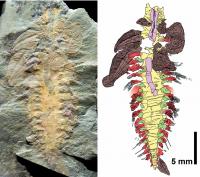
Fossil (left) and depiction (right) of extinct armored machaeridian worm. Colors indicate the trunk (yellow), limb (red), bristles (gray), attachment of shell plates (green), gut (purple) and dorsal linear structure (blue) Credit: Vinther, et al Nature Discovery of an exceptional fossil specimen in southeastern Morocco that preserves evidence of the animal’s soft tissues has solved a paleontological puzzle about the origins of an extinct group of bizarre slug-like animals with rows of mineralized armor plates on their backs, according to a paper in Nature.
While evolution has produced great diversity in the body designs of animals, over the course of history several highly distinct groups, such as trilobites and ammonites, have become extinct. The new fossil is of an unusual creature known as a machaeridian, an invertebrate, or animal without a backbone, that existed for about 180 million years from 485 to 305 million years ago.
“The new specimen unequivocally identifies machaeridians as annelid worms, an extremely successful and diverse group of animals that includes familiar living animals like the sea mouse, the earthworm and the leech,” said Jakob Vinther, graduate student in the Department of Geology & Geophysics at Yale. The specimen was found in an area that had earlier been identified as a rich source of exceptionally preserved fossils including sponges, trilobites, echinoderms and other less-familiar invertebrates.
First described over 150 years ago, armor plates of these strange animals have been found in marine fossil deposits worldwide covering the time span of their existence, and indicating that they were an important component of ancient seafloor ecosystems. Until now there was little information about their body design or how they might be related to other ancient — or currently living — animals.
“These animals disintegrated quickly after death, so complete fossils of their dorsal armor are rare, and their record until now consisted mostly of isolated armor plates scattered in the sediment,” said Vinther. The dilemma of studying ancient organisms, he notes, is that the soft body parts, including most internal organs, are unavailable for study because they usually decompose before they can become fossilized.
Previous patchy evidence was insufficient to reveal the relationships of the machaeridians to other animals and there was much speculation about their position in the tree of life. Different authors suggested relationships to groups as varied as mollusks (clams and snails), barnacles (crustaceans — including shrimps, crabs and crayfish), echinoderms (starfish and sea urchins) and annelid worms (aquatic bristle worms and garden earthworms).
This inch-long specimen that was recently discovered shows that, below the dorsal armor, the machaeridians had an elongate body with paired, soft, limb-like extensions on each segment, and two bundles of long, stiff bristles on each extension. The segmented nature of the body, and especially the presence of soft “limbs” carrying bristles, unequivocally identified the machaeridians as annelid worms, say the scientists.
According to the authors, although the exact relationship of machaeridians within the annelid worms is still uncertain, the presence of modified scales suggests that they may even belong to a group of marine bristle worms that are still in existence today.
“This exciting discovery has provided important new insights into annelid evolution, showing that some of these worms, which first appeared during the Cambrian radiation, evolved a highly distinctive dorsal, mineralised armor early in their history,” said senior author Derek Briggs, the Frederick William Beinecke Professor of Geology and Geophysics at Yale University. “It also highlights the great importance of the study of exceptional fossil sites, and of palaeobiology in general, for a better understanding of the evolution of our biosphere.” Briggs, the director of the Yale Institute for Biospheric Studies, will assume the directorship of the Yale Peabody Museum of Natural History in July.
Source : Yale University
 Print Article
Print Article Mail to a Friend
Mail to a Friend
